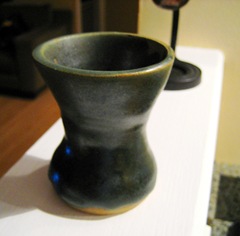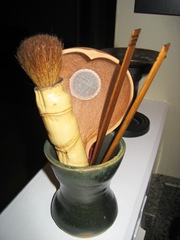It seems that there’s been some more chatter about Hong Shui Oolong recently. When I wrote this post about it back in July, I didn’t have much information about the tea beyond the books I have (in Chinese), the article about Dong Ding in the “Art of Tea” magazine (Issue #4), and some posts that Guang from Hou De had written.
In the last few months, there have been articles about Hong Shui from Floating Leaves Teahouse in Seattle and a recent one by Tea Parker in Taiwan (in Chinese), among others. Floating Leaves started carrying a Hong Shui oolong this past fall, and Hong Shui is a tea Stephane from the Tea Masters blog enjoys. A thoughtful and recent review of Tea Masters’ Hong Shui oolong can be found at MattCha’s blog.
Why the popularity in a tea that, as one producer in Tea Parker’s article put it, requires no small amount of effort and time?
Both Stephane and Hou De, among other tea retailers, have carried this tea for quite some time. There are also many reviews about this tea (from various retailers) online, but the problem is that I’m not quite sure – and many people may be in the same boat – about how to judge this tea. We can expect, for example, some green teas to be vegetal or grassy, some Taiwan High Mountain teas to be floral and aromatic, Baozhong to be light and crisp, etc. I expected an example of Hong Shui to taste like Dong Ding and instead thought that it tasted like a cross between a Yancha and an Oriental Beauty. I sent a sample to a tea friend recently and labeled it “oolong 2” for him to try, and he thought it was some kind of new hybrid oolong, tasty but not quite sure what to think about it.
With a clean slate for learning about its taste, I’m open to the unexpected flavors I’ve been getting from this tea. It has a body and character that can be deep and rich, like a Wuyi Yancha, from the high oxidation. It has energy and a robust mouth-feel from the roasting, but expertly done, it will be smooth and round. There is a sweetness in the brew that is characteristic of tea from Dong Ding; a velvety, fruit taste.
Taiwan Hong Shui Oolong – developed and perfected in Dong Ding – is a traditional, old-school production method for oolong from the Nantou area. My interest in understanding tea production techniques that still exist will undoubtedly lead me to try to learn more about Hong Shui in the near future, as well as to find a better translation for it than “Red Water Oolong” or “Crimson Brewed Oolong.” What if the Shui (水) refers not to water itself, but to a part of the processing, like the 走水 part of oxidation? Makes sense to me, but let’s see what the old masters have to say about it.
In the meantime, try some of the season’s new, good teas that have come out and enrich your life.










